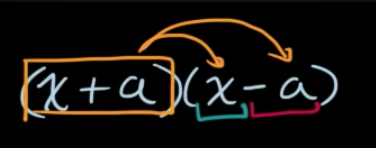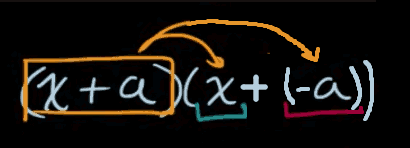Hi all,
I'm trying to understand how the distributive law applies to expressions involving negative numbers and how, when reading an expression, to distinguish between a negative number and a subtraction operation.
In this Khan Academy video - Difference of squares intro - the following expression is given:
(x+a)(x−a)
The narrator then goes on to apply (x+a) to first x, then −a.
For some reason I find this counter-intuitive.
My default way of thinking was to treat x and a as terms, but − as an operator between those terms. So my first instinct was to apply (x+a) to first x, then to a, and then to subtract the the latter from the former.
I guess when I see a − sign, I assume it is a subtraction, because a lot of the time it actually is. But it seems my default way is wrong and instead I should have been treating −a as a unit, meaning "negative a".
But now I feel confused because I don't know how to differentiate between the use of the minus sign as part of a term vs. as an operator, when applying the distributive law.
Suppose the expression was instead:
(x+a)(x÷a)
Then should I apply (x+a) to first x, then to ÷a? But how could I multiply by ÷a? How can such a term as "divided-by-a" even exist? That's nonsensical!
So evidently the subtraction symbol, −, is a special case, as, unlike most other operators, it can mean either subtraction or a prefix which makes the number following it a negative number, and so its meaning has to be partly determined based on context and it is not guaranteed that in all cases it is an operator.
So I guess it's probably simple enough to determine which meaning is intended in most cases, but still I find this very confusing.
Does my reasoning make sense, or can you see a more fundamental flaw in my thinking?
Thanks in advance.
I'm trying to understand how the distributive law applies to expressions involving negative numbers and how, when reading an expression, to distinguish between a negative number and a subtraction operation.
In this Khan Academy video - Difference of squares intro - the following expression is given:
(x+a)(x−a)
The narrator then goes on to apply (x+a) to first x, then −a.
For some reason I find this counter-intuitive.
My default way of thinking was to treat x and a as terms, but − as an operator between those terms. So my first instinct was to apply (x+a) to first x, then to a, and then to subtract the the latter from the former.
I guess when I see a − sign, I assume it is a subtraction, because a lot of the time it actually is. But it seems my default way is wrong and instead I should have been treating −a as a unit, meaning "negative a".
But now I feel confused because I don't know how to differentiate between the use of the minus sign as part of a term vs. as an operator, when applying the distributive law.
Suppose the expression was instead:
(x+a)(x÷a)
Then should I apply (x+a) to first x, then to ÷a? But how could I multiply by ÷a? How can such a term as "divided-by-a" even exist? That's nonsensical!
So evidently the subtraction symbol, −, is a special case, as, unlike most other operators, it can mean either subtraction or a prefix which makes the number following it a negative number, and so its meaning has to be partly determined based on context and it is not guaranteed that in all cases it is an operator.
So I guess it's probably simple enough to determine which meaning is intended in most cases, but still I find this very confusing.
Does my reasoning make sense, or can you see a more fundamental flaw in my thinking?
Thanks in advance.
Last edited:


